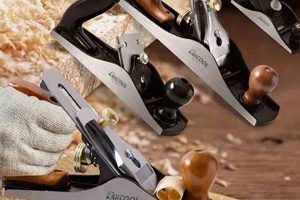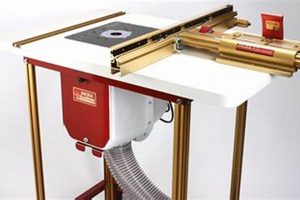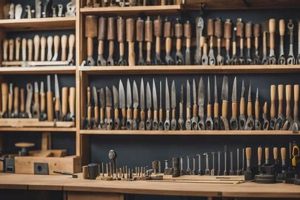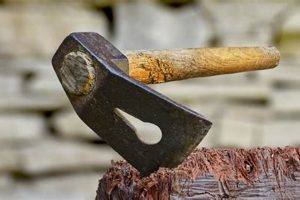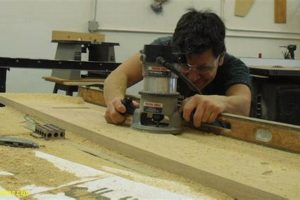The implements employed in traditional Japanese woodworking represent a distinct approach to shaping and joining wood. These instruments, often characterized by their pull-stroke action and meticulous craftsmanship, facilitate precise and clean cuts. Examples include saws designed for specific grains, chisels honed to exceptional sharpness, and planes capable of creating surfaces with unparalleled smoothness.
The reliance on these specialized instruments promotes efficiency and accuracy in joinery. Their design minimizes tear-out and allows for the creation of intricate and durable structures. The historical development of this toolset reflects a deep understanding of wood properties and a commitment to preserving traditional techniques. Using these tools allows craftspeople to create robust and beautiful woodworking projects that showcase the natural elegance of the material.
The following sections will elaborate on the core set used in this craft, focusing on the distinctions and usage of saws, planes, chisels, and marking tools, providing details regarding their application and essential features that define their function.
Practical Guidance
This section offers guidance on proper selection and maintenance of tools, critical for maximizing their performance and lifespan. Careful consideration during acquisition and diligent upkeep are essential for successful application of the instruments.
Tip 1: Steel quality is paramount: Prioritize tools forged from high-carbon steel. This ensures superior edge retention and durability, crucial for demanding woodworking tasks. Examine the steel composition when purchasing, as it directly impacts the tool’s performance under stress.
Tip 2: Master sharpening techniques: Understanding sharpening principles is fundamental. Invest in quality sharpening stones and practice consistently to maintain a razor-sharp edge. Dull tools are less efficient and increase the risk of accidents.
Tip 3: Choose the correct saw for the task: Saws are designed for specific cuts (rip or crosscut). Using the inappropriate saw leads to inefficient cutting and potential damage to the material. Observe the tooth pattern and set to identify the intended cut type.
Tip 4: Plane adjustment is critical: Precise plane adjustment is crucial for achieving smooth surfaces. Pay attention to the blade projection and mouth opening to ensure optimal performance. Minor adjustments can significantly impact the final surface quality.
Tip 5: Proper chisel handling ensures safety: Utilize proper grip and body positioning when using chisels. Never force the tool; allow the sharpness of the blade to do the work. Secure the workpiece adequately to prevent slippage.
Tip 6: Regular cleaning prevents rust: Clean and oil the tools regularly to prevent rust and corrosion. Moisture and wood sap can damage the metal components over time. This maintenance extends the tool’s life and preserves its performance.
Tip 7: Store tools properly: Store tools in a dry environment to prevent rust. Consider using tool rolls or dedicated storage racks to protect the edges and prevent accidental damage.
Implementing these practices will not only enhance the tool’s capabilities, but also contribute to a safer and more efficient woodworking experience. Consistent application of these techniques ensures the longevity and optimal performance of each instrument.
The final section will delve into the application and techniques used while utilizing these woodworking instruments.
1. Sharpness
Within the realm of Japanese woodworking, sharpness transcends mere functionality; it represents a foundational principle dictating the efficiency, precision, and overall quality achievable with traditional instruments. The pursuit and maintenance of exceptional sharpness are integral to the proper utilization of this toolset.
- Edge Retention and Steel Composition
The ability of a tool to maintain a keen edge is directly linked to the steel’s composition and hardness. High-carbon steels, common in quality Japanese woodworking tools, allow for the creation of extremely sharp edges that endure through prolonged use. The selection of appropriate steel types is critical for both initial sharpness and long-term edge durability.
- Pull-Stroke Efficiency
The pull-stroke cutting action, characteristic of many Japanese saws and knives, leverages sharpness to its full potential. The blade’s geometry, combined with the pulling force, enables cleaner and more precise cuts with less force. An acutely sharp edge minimizes resistance and splintering, resulting in smoother surfaces and tighter joinery.
- Surface Finish and Grain Interaction
Sharpness directly impacts the quality of the final surface. Chisels and planes with exceptionally keen edges can sever wood fibers cleanly, minimizing tear-out and producing surfaces that require minimal sanding. This is particularly crucial when working with hardwoods or figured grains, where even minor imperfections become readily apparent.
- Safety and Control
Counterintuitively, a sharp tool is safer than a dull one. A dull tool requires excessive force, increasing the risk of slipping and loss of control. A sharp tool, on the other hand, cuts with minimal pressure, allowing for precise maneuvering and reducing the likelihood of accidents. Sharpness is therefore not merely a performance attribute but also a key element of safe working practices.
These facets underscore the critical role of sharpness in Japanese woodworking. It is not simply a desirable attribute but rather a fundamental requirement for achieving the precision, efficiency, and aesthetic quality that define this craft. Maintaining the sharpness of these implements is therefore a constant and essential aspect of the woodworker’s practice, inextricably linked to the proper use and appreciation of these tools.
2. Steel Quality
The performance and longevity of essential Japanese woodworking tools are inextricably linked to the quality of steel used in their construction. Steel quality dictates edge retention, resistance to wear, and the overall durability of the tool under rigorous use. The selection of appropriate steel types is not merely a preference, but a critical factor in achieving precise and efficient woodworking.
For example, high-carbon steels, such as White Steel (Shirogami) and Blue Steel (Aogami), are frequently employed in crafting blades for saws, chisels, and planes. These steels allow for the creation of exceptionally sharp edges capable of cleanly severing wood fibers. The addition of alloying elements like tungsten and chromium in Blue Steel enhances its wear resistance and toughness compared to White Steel, making it suitable for demanding applications and harder wood species. Conversely, using low-quality steel leads to rapid dulling, increased frequency of sharpening, and diminished control over the cutting process. This not only impacts the efficiency of the woodworking task but also compromises the precision and quality of the final product. A practical demonstration of steel’s importance can be observed in the longevity and performance of a well-maintained chisel made with high-carbon steel compared to a similar tool made from inferior material. The former will retain its edge longer and provide cleaner cuts, even after extended use.
Therefore, understanding the nuances of steel quality is paramount for anyone seeking to utilize essential Japanese woodworking tools effectively. The initial investment in tools made with high-quality steel translates to long-term benefits in terms of performance, durability, and the overall woodworking experience. While the initial cost may be higher, the reduced need for frequent replacements and the enhanced precision obtained justify the investment. Choosing tools based on their steel quality is a cornerstone of the craft, enabling woodworkers to achieve superior results and preserve the tradition of excellence associated with Japanese woodworking.
3. Pull Stroke
The defining characteristic of many essential Japanese woodworking tools is their operation via a pull stroke. Unlike Western counterparts that are predominantly push-oriented, Japanese saws, for instance, are designed to cut on the backward motion. This fundamental difference arises from a combination of factors, including blade thickness, tooth geometry, and the physical mechanics it affords the user. The pull stroke places the blade in tension, reducing the likelihood of buckling and enabling the use of thinner, harder blades capable of producing finer, more accurate cuts. Consider the difference between a traditional Japanese ryoba saw and a Western panel saw: the ryoba, designed for pull-stroke operation, achieves a kerf significantly narrower than that produced by the typically thicker and push-oriented panel saw. This directly affects material usage and joinery precision. Furthermore, the pull stroke is not limited to saws. Japanese knives and some chisels also utilize a pulling motion for controlled slicing and paring.
The benefits of the pull stroke extend beyond simply achieving finer cuts. The operator typically has a clearer view of the cut line during the pull stroke, enhancing control and precision. The pulling action also allows for a more natural and ergonomic body position, reducing fatigue during prolonged use. In practical applications, this translates to cleaner joinery with tighter fits and a reduced need for corrective sanding or filling. For example, creating intricate dovetail joints benefits significantly from the control offered by a pull-stroke saw, allowing for precise cuts along the dovetail angles. Additionally, the pulling action reduces the force required to initiate and maintain the cut, especially when working with hardwoods. This is particularly advantageous in traditional Japanese construction, where hardwoods are commonly used for structural elements and decorative details. It also makes the tools more accessible to a wider range of woodworkers, regardless of their physical strength.
In summary, the pull stroke is not merely a technique; it is an integral design element deeply intertwined with the functionality and precision of essential Japanese woodworking tools. It directly influences blade design, cutting efficiency, user ergonomics, and the quality of the final workpiece. The emphasis on tension over compression allows for finer cuts, improved control, and reduced fatigue, making the pull stroke a defining feature of this distinct woodworking tradition. Understanding the principles and advantages of the pull stroke is crucial for properly utilizing and appreciating the capabilities of these specialized tools.
4. Specific Purpose
The design philosophy behind essential Japanese woodworking tools is deeply rooted in the concept of specialization. Each instrument is meticulously crafted and intended for a narrowly defined range of tasks. This dedication to specific purpose is a defining characteristic and a key factor in the precision and efficiency associated with traditional Japanese woodworking.
- Saw Design Variation
Unlike universal saws common in other woodworking traditions, Japanese saws (nokogiri) are highly differentiated based on tooth geometry, blade thickness, and intended use. A ryoba, with its two distinct edges (one for rip cuts and one for crosscuts), exemplifies this specialization. Similarly, a dozuki, with its stiffening back, is designed exclusively for fine joinery where precision is paramount. The selection of the appropriate saw for the specific cut is crucial for achieving optimal results and preventing damage to the material.
- Chisel Differentiation
Japanese chisels (nomi) exhibit a similar level of specialization. Different chisel types are designed for mortising, paring, or general shaping. A mortise chisel, with its robust blade and thick cross-section, is intended for removing large amounts of material in mortise joints. A paring chisel, conversely, possesses a thin, flexible blade for delicate shaving and fine adjustments. Attempting to use a mortise chisel for paring or vice versa would compromise both the quality of the work and the integrity of the tool.
- Plane Specialization
Japanese planes (kanna) are available in numerous variations, each optimized for a particular task or wood type. Smoothing planes, block planes, and specialty planes for creating decorative moldings represent only a fraction of the available options. Each plane is meticulously adjusted for the specific type of cut it is intended to perform, and the blade angle, mouth opening, and sole configuration are all tailored to optimize performance. Utilizing a plane designed for softwood on a dense hardwood, for example, would likely result in unsatisfactory results and potential damage to the blade.
- Marking and Measuring Tools
Even marking and measuring tools are designed with specific applications in mind. The sumitsubo, a traditional ink pot and marking device, allows for the creation of long, straight lines on lumber. Marking knives are used to scribe precise lines for joinery, providing a clear visual reference for chisel work. These specialized marking tools ensure accuracy and repeatability in layout and construction.
The emphasis on specific purpose in Japanese woodworking tools reflects a deep understanding of wood properties and the requirements of various woodworking tasks. By selecting the appropriate tool for each specific application, woodworkers can achieve superior results in terms of precision, efficiency, and the overall quality of the finished product. This dedication to specialization is a hallmark of traditional Japanese woodworking and a key factor in its enduring appeal.
5. Precision
Precision is not merely a desired outcome, but an inherent characteristic embedded within the design and application of essential Japanese woodworking tools. The pursuit of accuracy and meticulous detail underpins the entire woodworking process, influencing tool selection, technique, and the final quality of the finished product.
- Blade Geometry and Cutting Accuracy
The thin, precisely sharpened blades found on Japanese saws and chisels are designed to minimize material waste and maximize cutting accuracy. The pull-stroke action, characteristic of many of these tools, further enhances control and reduces the risk of deviation from the intended cut line. This results in tighter joinery and more refined surfaces, essential for creating durable and aesthetically pleasing structures.
- Tool Balance and User Control
The design of Japanese woodworking tools prioritizes balance and ergonomic form, enabling users to maintain a high degree of control throughout the cutting process. The weight distribution and handle shape are carefully considered to minimize fatigue and maximize sensitivity, allowing for precise movements and subtle adjustments. This intimate connection between tool and user is crucial for achieving consistent and accurate results.
- Specialized Tooling for Specific Tasks
The availability of a wide array of specialized tools, each designed for a specific woodworking task, contributes significantly to the overall precision achievable. From intricate dovetail saws to finely tuned smoothing planes, each instrument is engineered to perform its intended function with unparalleled accuracy. This specialization eliminates guesswork and reduces the margin for error, leading to more predictable and precise outcomes.
- Rigorous Sharpening and Maintenance Practices
The emphasis on meticulous sharpening and maintenance is integral to maintaining the precision of Japanese woodworking tools. A dull blade compromises accuracy and increases the risk of material damage. Regular sharpening, using traditional water stones and honing techniques, ensures that the tools are always performing at their optimal level, enabling woodworkers to achieve the finest possible results. Precise maintenance ensures that the tool is capable of delivering the precision it was designed for.
The various facets underscore the importance of precision. These features are woven into the very fabric of essential Japanese woodworking tools, making it an indispensable element for achieving exceptional results. From the initial design to the final finishing touches, the pursuit of precision guides every aspect of the woodworking process, ensuring the creation of enduring and aesthetically refined objects.
6. Blade Angle
The blade angle is a critical determinant of performance in essential Japanese woodworking tools. This angle, defined as the inclination of the cutting edge relative to the workpiece, directly influences the efficiency, smoothness, and precision of the cut. The blade angle is not arbitrary; it is carefully chosen based on the intended application of the tool, the type of wood being worked, and the desired finish. For instance, a lower blade angle on a Japanese smoothing plane (kanna) is preferred for creating extremely smooth surfaces on hardwoods, while a higher angle might be more suitable for removing material quickly from softer woods. This direct correlation between blade angle and cutting performance underscores its importance as a fundamental design element.
Variations in blade angle across different tool types highlight the specialization inherent in the Japanese woodworking tradition. Japanese chisels (nomi), for example, feature a range of blade angles depending on their intended use. Mortise chisels, designed for heavy material removal, typically have a steeper bevel angle to withstand the forces involved. Paring chisels, on the other hand, have a shallower angle for delicate shaving and precise adjustments. Similarly, the blade angle of a Japanese saw (nokogiri) affects its cutting speed and the aggressiveness of the cut. A saw designed for ripping along the grain will have a different tooth geometry and rake angle compared to a saw designed for crosscutting. Understanding these nuances allows the woodworker to select the appropriate tool for each specific task, optimizing cutting efficiency and minimizing the risk of tear-out or other undesirable results.
In summary, the blade angle is a fundamental parameter that significantly affects the performance of essential Japanese woodworking tools. Its careful selection and precise maintenance are crucial for achieving the accuracy, efficiency, and quality characteristic of this craft. The interconnectedness of blade angle with tool design, wood type, and desired outcome reinforces its role as a vital component of the traditional Japanese woodworking process. Misunderstanding or neglecting the importance of blade angle can lead to inefficient cutting, damaged tools, and compromised results, underscoring the practical significance of this knowledge for any practitioner of the craft.
7. Maintenance
The longevity and performance of essential Japanese woodworking tools are directly proportional to the diligence of their maintenance. Consistent and appropriate care preserves the integrity of the tool and ensures the continued precision that defines this craft. Neglecting maintenance practices inevitably leads to diminished performance, increased risk of damage, and a shortened lifespan of these valuable instruments.
- Sharpening Regimen
Maintaining a keen edge is paramount for any cutting tool. For essential Japanese woodworking tools, this necessitates a consistent sharpening regimen using progressively finer water stones. This process not only restores the cutting edge but also refines the blade geometry, ensuring optimal performance. Neglecting sharpening results in increased force required for cutting, leading to reduced precision and potential damage to the workpiece.
- Rust Prevention
The high-carbon steel commonly used in Japanese woodworking tools is susceptible to rust. Preventive measures, such as regular cleaning and the application of protective oils, are crucial for mitigating corrosion. Environmental factors, such as humidity and exposure to moisture, accelerate the rusting process. Failure to implement adequate rust prevention strategies results in weakened structural integrity and diminished cutting performance.
- Handle and Blade Connection Integrity
The connection between the blade and handle is a critical point of potential failure. Regular inspection and maintenance of this connection are essential for ensuring safe and efficient operation. Loosening or instability can compromise control and increase the risk of accidents. Proper tightening and, when necessary, re-seating of the blade within the handle are vital maintenance tasks.
- Storage Practices
Proper storage protects tools from environmental damage and physical impact. Storing tools in a dry, protected environment minimizes the risk of rust and warping. Utilizing tool rolls or dedicated storage racks prevents accidental damage and preserves the sharpness of cutting edges. Neglecting proper storage accelerates deterioration and reduces the overall lifespan of the tool.
These facets collectively illustrate the indispensable role of maintenance in preserving the functionality and extending the lifespan of essential Japanese woodworking tools. Diligent adherence to these practices ensures that these instruments remain capable of delivering the precision and efficiency for which they are renowned. The longevity of these essential tools hinges on diligent maintenance.
Frequently Asked Questions
This section addresses common inquiries regarding the selection, utilization, and maintenance of essential Japanese woodworking tools, offering concise and informative responses.
Question 1: What distinguishes Japanese saws (nokogiri) from Western saws?
Japanese saws typically cut on the pull stroke, allowing for thinner blades and finer cuts. Western saws generally cut on the push stroke and often feature thicker blades. This difference in cutting action impacts the precision and efficiency of the saw.
Question 2: Why is sharpness so critical for Japanese chisels (nomi)?
Exceptional sharpness is essential for clean, precise cuts, minimizing tear-out and allowing for intricate joinery. Dull chisels require more force, increasing the risk of errors and damage to the workpiece.
Question 3: What are the primary considerations when selecting a Japanese plane (kanna)?
The intended application and the type of wood being worked are key factors. Different planes are designed for specific tasks, such as smoothing, shaping, or creating moldings. The blade angle and sole configuration should be appropriate for the wood species being used.
Question 4: How frequently should Japanese woodworking tools be sharpened?
Sharpening frequency depends on usage and the type of wood being worked. However, regular honing and periodic sharpening are essential for maintaining optimal performance. A decrease in cutting efficiency indicates the need for immediate sharpening.
Question 5: What is the purpose of the sumitsubo, and how is it used?
The sumitsubo is a traditional Japanese marking tool used to create straight lines. It consists of an ink pot, a thread reel, and a marking point. The thread is inked and then snapped against the workpiece to leave a precise line.
Question 6: What are the best practices for storing Japanese woodworking tools?
Tools should be stored in a dry, protected environment to prevent rust and physical damage. Tool rolls or dedicated storage racks are recommended to protect cutting edges and prevent accidental impacts.
These questions and answers provide a foundation for understanding key aspects of this specialized toolset. The information presented is intended to guide proper selection, use, and care.
The following section will address expert recommendations for purchasing and using these implements.
Essential Japanese Woodworking Tools
This exploration has illuminated the defining characteristics of essential Japanese woodworking tools, emphasizing their specialized design, the critical role of steel quality, and the unique pull-stroke cutting action. The importance of precision, the impact of blade angle, and the necessity of diligent maintenance have been thoroughly addressed. Understanding these aspects is paramount for anyone seeking to effectively employ these instruments.
The informed application of these tools represents a commitment to a time-honored tradition of craftsmanship. Continued study and practice are encouraged to fully realize their potential and to contribute to the preservation of this valuable woodworking heritage. The pursuit of excellence through the mastery of these instruments remains a worthwhile endeavor.


